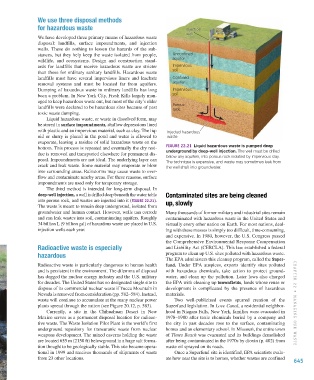Page 646 - Environment: The Science Behind the Stories
P. 646
We use three disposal methods
for hazardous waste Injection
well
We have developed three primary means of hazardous waste
disposal: landfills, surface impoundments, and injection
wells. These do nothing to lessen the hazards of the sub-
stances, but they help keep the waste isolated from people, Unconfined
wildlife, and ecosystems. Design and construction stand- aquifer
ards for landfills that receive hazardous waste are stricter Impervious
than those for ordinary sanitary landfills. Hazardous waste soil
landfills must have several impervious liners and leachate Confined
removal systems and must be located far from aquifers. aquifer
Dumping of hazardous waste in ordinary landfills has long Impervious
been a problem. In New York City, Fresh Kills largely man- soil
aged to keep hazardous waste out, but most of the city’s older
landfills were declared to be hazardous sites because of past Porous
rock
toxic waste dumping.
Liquid hazardous waste, or waste in dissolved form, may
be stored in surface impoundments, shallow depressions lined
with plastic and an impervious material, such as clay. The liq- Injected hazardous
uid or slurry is placed in the pond and water is allowed to waste
evaporate, leaving a residue of solid hazardous waste on the
bottom. This process is repeated and eventually the dry resi- FIGURE 22.21 Liquid hazardous waste is pumped deep
due is removed and transported elsewhere for permanent dis- underground by deep-well injection. The well must be drilled
below any aquifers, into porous rock isolated by impervious clay.
posal. Impoundments are not ideal. The underlying layer can The technique is expensive, and waste may sometimes leak from
crack and leak waste. Some material may evaporate or blow the well shaft into groundwater.
into surrounding areas. Rainstorms may cause waste to over-
flow and contaminate nearby areas. For these reasons, surface
impoundments are used only for temporary storage.
The third method is intended for long-term disposal. In
deep-well injection, a well is drilled deep beneath the water table Contaminated sites are being cleaned
into porous rock, and wastes are injected into it (FIGURE 22.21). up, slowly
The waste is meant to remain deep underground, isolated from
groundwater and human contact. However, wells can corrode Many thousands of former military and industrial sites remain
and can leak wastes into soil, contaminating aquifers. Roughly contaminated with hazardous waste in the United States and
34 billion L (9 billion gal) of hazardous waste are placed in U.S. virtually every other nation on Earth. For most nations, deal-
injection wells each year. ing with these messes is simply too difficult, time-consuming,
and expensive. In 1980, however, the U.S. Congress passed
the Comprehensive Environmental Response Compensation
Radioactive waste is especially and Liability Act (CERCLA). This law established a federal
hazardous program to clean up U.S. sites polluted with hazardous waste.
The EPA administers this cleanup program, called the Super-
Radioactive waste is particularly dangerous to human health fund. Under EPA auspices, experts identify sites polluted
and is persistent in the environment. The dilemma of disposal with hazardous chemicals, take action to protect ground-
has dogged the nuclear energy industry and the U.S. military water, and clean up the pollution. Later laws also charged
for decades. The United States has no designated single site to the EPA with cleaning up brownfields, lands whose reuse or
dispose of its commercial nuclear waste if Yucca Mountain in development is complicated by the presence of hazardous
Nevada is removed from consideration (pp. 582–584). Instead, materials.
waste will continue to accumulate at the many nuclear power Two well-publicized events spurred creation of the
plants spread through the nation (see Figure 20.12, p. 583). Superfund legislation. In Love Canal, a residential neighbor- CHAPTER 22 • MAN A GING OUR WASTE
Currently, a site in the Chihuahuan Desert in New hood in Niagara Falls, New York, families were evacuated in
Mexico serves as a permanent disposal location for radioac- 1978–1980 after toxic chemicals buried by a company and
tive waste. The Waste Isolation Pilot Plant is the world’s first the city in past decades rose to the surface, contaminating
underground repository for transuranic waste from nuclear homes and an elementary school. In Missouri, the entire town
weapons development. The mined caverns holding the waste of Times Beach was evacuated and its buildings demolished
are located 655 m (2150 ft) belowground in a huge salt forma- after being contaminated in the 1970s by dioxin (p. 402) from
tion thought to be geologically stable. This site became opera- waste oil sprayed on its roads.
tional in 1999 and receives thousands of shipments of waste Once a Superfund site is identified, EPA scientists evalu-
from 23 other locations. ate how near the site is to homes, whether wastes are confined 645
M22_WITH7428_05_SE_C22.indd 645 13/12/14 2:25 PM

